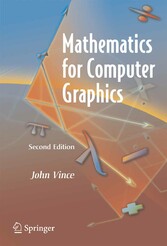Suchen und Finden
Contents
6
Preface
12
1 Mathematics
14
1.1 Is Mathematics Difficult?
15
1.2 Who should Read this Book?
15
1.3 Aims and Objectives of this Book
16
1.4 Assumptions Made in this Book
16
1.5 How to Use the Book
16
2 Numbers
18
2.1 Natural Numbers
18
2.2 Prime Numbers
19
2.3 Integers
19
2.4 Rational Numbers
19
2.5 Irrational Numbers
19
2.6 Real Numbers
20
2.7 The Number Line
20
2.8 Complex Numbers
20
2.9 Summary
22
3 Algebra
23
3.1 Notation
23
3.2 Algebraic Laws
24
3.3 Solving the Roots of a Quadratic Equation
26
3.4 Indices
27
3.5 Logarithms
27
3.6 Further Notation
28
3.7 Summary
28
4 Trigonometry
29
4.1 The Trigonometric Ratios
30
4.2 Example
30
4.3 Inverse Trigonometric Ratios
31
4.4 Trigonometric Relationships
31
4.5 The Sine Rule
32
4.6 The Cosine Rule
32
4.7 Compound Angles
32
4.8 Perimeter Relationships
33
4.9 Summary
34
5 Cartesian Coordinates
35
5.1 The Cartesian xy-plane
35
5.2 3D Coordinates
40
5.3 Summary
41
6 Vectors
42
6.1 2D Vectors
43
6.2 3D Vectors
45
6.3 Deriving a Unit Normal Vector for a Triangle
58
6.4 Areas
59
6.5 Summary
60
7 Transformation
61
7.1 2D Transformations
61
7.2 Matrices
63
7.3 Homogeneous Coordinates
67
7.4 3D Transformations
76
7.5 Change of Axes
83
7.6 Direction Cosines
85
7.7 Rotating a Point about an Arbitrary Axis
93
7.8 Transforming Vectors
108
7.9 Determinants
109
7.10 Perspective Projection
113
7.11 Summary
115
8 Interpolation
116
8.1 Linear Interpolant
116
8.2 Non-Linear Interpolation
119
8.3 Interpolating Vectors
125
8.4 Interpolating Quaternions
128
8.5 Summary
130
9 Curves and Patches
131
9.1 The Circle
131
9.2 The Ellipse
132
9.3 Bézier Curves
133
9.4 A recursive Bézier Formula
141
9.5 Bézier Curves Using Matrices
141
9.6 B-Splines
145
9.7 Surface Patches
149
9.8 Summary
154
10 Analytic Geometry
155
10.1 Review of Geometry
155
10.2 2D Analytical Geometry
164
10.3 Intersection Points
169
10.4 Point Inside a Triangle
172
10.5 Intersection of a Circle with a Straight Line
176
10.6 3D Geometry
177
10.7 Equation of a Plane
181
10.8 Intersecting Planes
189
10.9 Summary
199
11 Barycentric Coordinates
200
11.1 Ceva’s Theorem
200
11.2 Ratios and Proportion
202
11.3 Mass Points
203
11.4 Linear Interpolation
209
11.5 Convex Hull Property
215
11.6 Areas
216
11.7 Volumes
224
11.8 Bézier Curves and Patches
227
11.9 Summary
228
12 Worked Examples
229
12.1 Calculate the Area of a Regular Polygon
229
12.2 Calculate the Area of any Polygon
230
12.3 Calculate the Dihedral Angle of a Dodecahedron
230
12.4 Vector Normal to a Triangle
232
12.5 Area of a Triangle using Vectors
233
12.6 General Form of the Line Equation from Two Points
233
12.7 Calculate the Angle between Two Straight Lines
234
12.8 Test If Three Points Lie On a Straight Line
235
12.9 Find the Position and Distance of the Nearest Point on a Line to a Point
236
12.10 Position of a Point Re.ected in a Line
238
12.11 Calculate the Intersection of a Line and a Sphere
240
12.12 Calculate if a Sphere Touches a Plane
244
12.13 Summary
245
13 Conclusion
246
References
247
Index
248
Alle Preise verstehen sich inklusive der gesetzlichen MwSt.









